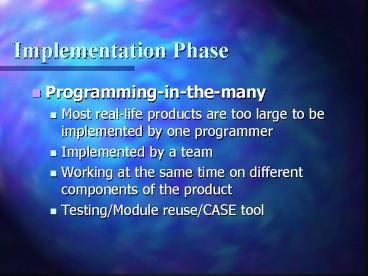Implementation Phase - PowerPoint PPT Presentation
1 / 9
Title:
Implementation Phase
Description:
Fourth Generation Languages (4GL) 1GL: a binary machine code. 2GL: ... of a hierarchy of lower-level functions, functional testing proceeds recursively. ... – PowerPoint PPT presentation
Number of Views:155
Avg rating:3.0/5.0
Title: Implementation Phase
1
Implementation Phase
- Programming-in-the-many
- Most real-life products are too large to be
implemented by one programmer - Implemented by a team
- Working at the same time on different components
of the product - Testing/Module reuse/CASE tool
2
Implementation Phase
- Fourth Generation Languages (4GL)
- 1GL a binary machine code
- 2GL assemblers (1940-50s)
- 3GL high level languages (FORTRAN, ALGOL 60,
COBOL, etc) - 4GL DB2, Oracle, PowerBuilder, SQL (1970s)
- shorter (30-50 MCI),
- easier to maintain/use,
- CASE Tool more productive, cost effective
3
Implementation Phase
- Good Programming Practice
- Use of consistent and meaningful identifier names
- Self-documenting code/documentation
- Use of Parameters
- Code layout for increased readability
- Coding style for incremental programming (Module
reuse)
4
Implementation Phase (Types of Errors)
- Syntax Errors
- Logic/Algorithm Errors
- Branching too soon/ too late
- Testing the wrong condition
- Initialization errors
- Data type mismatch
- Incorrect formula or computation
- Documentation Errors - mismatch between
documentation and code leads to difficulties
especially during maintenance
5
Implementation Phase (Types of Errors)
- Capacity Errors - system performance degradation
at capacity - Hardware Errors
- Throughput/performance Errors
- Computation/precision Errors
- Stress/overload Errors
- Recovery Errors - error handling faults
- Standards/Procedures - created/introduced as the
system is tested modified
6
Implementation Phase (Testing Principles)
- Process of finding errors
- Impossible to completely test software
- Creativity and hard work required
- Error prevention
- Independent testers
7
Implementation Phase (Testing Steps)
- Select what is to be measured by the test and
decide how the code will be tested - Develop the test cases for the code and
determine the correct results for the test cases - Execute the test cases and compare the actual
results with the expected results - Regression Testing -If errors are discovered,
earlier test cases should be re-executed.
8
Black-box Testing
- focused on inputs and outputs of a module
equivalence partitioning, equivalence class
contains similar test cases (reduce redundancy) - equivalence Testing Boundary Value Analysis
- If valid input is a range of values, there are a
minimum of three equivalence classes one below
the range, one within the range, and one above
the range - If valid input is a value from a discrete set of
values, there are two equivalence classes valid,
discrete values and any other input values.
9
Black-box Testing
- Functional Testing
- demonstrate that all functions work according to
requirements and specification document - determining all the functions of the module
- test data are devised to test each function
separately - If the module consists of a hierarchy of
lower-level functions, functional testing
proceeds recursively. - OSBERT OGLES BY CASE STUDY (13.16)































